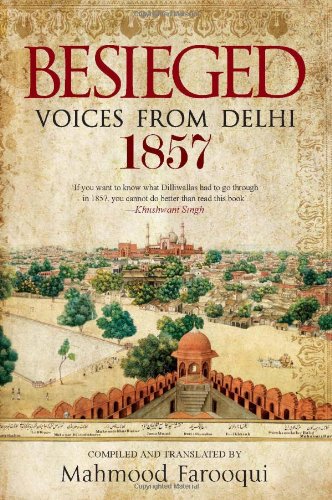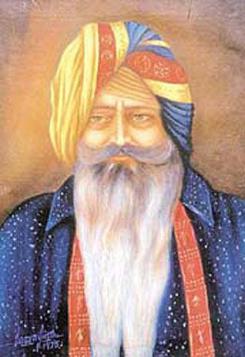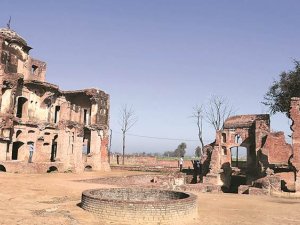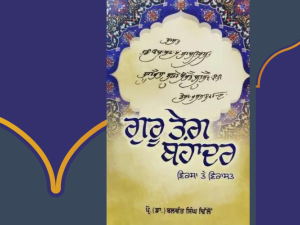Background
 The general Indian masses are taught that Sikhs sided with the British East India Company during the revolt of 1857. The Sikh princely states of Patiala and others in Cis Sutlej area definitely supported British during the Sepoy Mutiny but so did the Maratha states (Scindia, Gaekwad & Holkar) and Rajput states (Jaipur, Jodhpur and Hill Rajputs including Jammu). They all had a subsidiary alliance with the British. According to Dr RC Majumdar & Dr SN Sen, the revolt of 1857 became a popular movement only in Uttar Pradesh, Delhi, Jhansi and some surrounding areas. In rest of the country it was a Sepoy Mutiny.
The general Indian masses are taught that Sikhs sided with the British East India Company during the revolt of 1857. The Sikh princely states of Patiala and others in Cis Sutlej area definitely supported British during the Sepoy Mutiny but so did the Maratha states (Scindia, Gaekwad & Holkar) and Rajput states (Jaipur, Jodhpur and Hill Rajputs including Jammu). They all had a subsidiary alliance with the British. According to Dr RC Majumdar & Dr SN Sen, the revolt of 1857 became a popular movement only in Uttar Pradesh, Delhi, Jhansi and some surrounding areas. In rest of the country it was a Sepoy Mutiny.
The Sikhs from Maharaja Ranjit Singh's territory (known as Manjha Sikhs) were not recruited for they were considered unreliable by the British as they had fought British twice in a span of 3 years (1845/46 & 1848/49). However Sikhs from Cis Sutlej region were recruited to form Regiment of Ludhiana and Regiment of Ferozepur in 1846. Shamsul Islam did a yeoman service in 2007 by writing Rebel Sikhs in 1857 where using contemporary Indian and British sources he gave instances where Sikhs joined the uprising of 1857. Among the academic circles it is known for a long time that Sikhs were both among the 'rebels' and forces besieging Delhi during May-September 1857 but this is practically unknown among Indian population. Let us chalk out the Sikh participation among 'rebels' at various places.
Delhi - Munshi Jeewan Lal's diary
Munshi Jeewan Lal was the head clerk attached to the British Governor General's agent at Delhi when 'rebel' sepoys at Delhi declared independence on 11th May 1857. Jeewan Lal was instructed to stay back in Delhi and provided information to British, basically work as a spy. Jewan Lal maintained a diary which was translated and published by Charles Theophilus Metcalfe, a senior British official and a benefactor of Jeewan Lal in 1885. The diary contained material and information to be passed to the British who had besieged the city. The following entries in the book Two Narratives of the Mutiny in Delhi about the participation of Sikhs in the rebellion and defence of Delhi will be an eye-opener to for many
28th May 1857
"About 200 men arrived from Lahore and Ferozepur to join the mutineers."
1st June 1857
"News came from Patiala that the two native regiments sent to assist the English had joined the mutineers, and, had had a fight with the English. It was reported that the whole of the Patiala force was hostile to the English. The soldiers openly remonstrated with the Maharajah for sympathizing with the English, when the natives were fighting in defence of their religion. They reminded him that he had gained nothing by his behaviour during the Punjab war…"
27th July 1857
"Today two Sikhs came on behalf of the chiefs of Lahore to say that 200,000 cartridges had been safely delivered to the troops in the Nimuch camp. Orders were issued that these were not to be wasted, as the supply in the Magazine was running short."
29th July 1857
"Several Sikhs, retainers of the Rajah Narunder Sing (Narinder Singh of Patiala), deserted from the English camp and appeared at the Durbar, and they reported that the English were' badly off for artillery horses, but had plenty of guns."
5th August 1857
"Certain Sikhs presented a petition complaining that they were in the habit of attacking the English entrenchments, but had to return, as the Purbeahs would give them no assistance and would not co-operate; they prayed the King to form a regiment of Sikhs from amongst the regiments of Delhi, and to entrust them with two field guns, that they might attack the English with some chance of success. They were encouraged, and told not to despair of victory."
26th August 1857
"Ghosh Mahommed, the General commanding the Nimuch force…asked for reinforcements. One regiment of Sikhs and four of cavalry were placed under his command."
Delhi - Mahmood Farooqui's book
 In 2010, Mahmood Farooqui wrote an excellent book on the revolt of 1857 in Delhi titled Besieged Voices from Delhi translating contemporary Persian and Urdu sources. The book makes lot of reference to Sikhs soldiers among the 'rebels'. The author has provided a timeline and particularly interesting are the entries relating to 21st August and 22nd August 1857 which are as follows
In 2010, Mahmood Farooqui wrote an excellent book on the revolt of 1857 in Delhi titled Besieged Voices from Delhi translating contemporary Persian and Urdu sources. The book makes lot of reference to Sikhs soldiers among the 'rebels'. The author has provided a timeline and particularly interesting are the entries relating to 21st August and 22nd August 1857 which are as follows
21st August 1857 - "Commander in Chief (Mirza Mughal) forwards Sikhs petition complaining discrimination (from Bengal regiment soldiers) and asking to be formed into a separate regiment."
22nd August 1857 - "Bahadur Shah Zafar tries to conciliate Sikhs in the Bareilly regiment."
Raja Narinder Singh of Patiala faced lot of rebellion. At least two regiments rebelled and joined the 'rebels' in Delhi. Some Sikh chiefs at Lahore and other Sikhs in Punjab also rebelled. The 5th August entry is very interesting. The Purbeahs (Easterners) were the soldiers from Uttar Pradesh & neighbouring areas from upper caste Hindu and Muslim backgrounds. They had mutinied now but in 1845/46 & 1848/49 they as part of British forces in Anglo-Sikh wars and they disliked and treated Sikhs badly.Frederic Cooper in his book The Crisis in the Panjab wrote that following annexation of Punjab, Purbeahs were given preference in jobs. The Sikhs and Punjabis suffered at the hands of Purbeahs soldiers and civil officials.
These Purbeahs soldiers (of Bengal regiment) were sent feelers to join Sikhs during those wars but none joined. Dr RC Majumdar has stated that second Anglo -Sikh war 1848/49 was the best option to ouster British from the country. The Sikhs and Punjabis blamed them for their defeat.
Here in 1857 these 'rebel' Sikhs were from Cis-Sutlej territories where rulers where pro-British since 1809 but it seems that the Bengal soldiers (the name of regiment was Bengal but soldiers were mostly from Uttar Pradesh) could not make the distinction between Trans-Sutlej Sikhs who mistrusted them and Cis-Sutlej who has no history of discontent with them.
Delhi - Abdul Latif's diary
Abdul Latif, an elite resident of Delhi wrote a diary in Persian during the siege of the Delhi by the British. The Urdu translation is titled Tareekhi Roznamcha. His diary is very good source of information. The important entries related to Sikhs are as follows
27th July 1857
"Few Sikhs after traveling all the way from Lahore appeared in the court of the King (Bahadur Shah Zafar) and made a representation that in Lahore it is rumoured that the King had decreed the beheading of Sikhs and announced a reward of ten rupees for every head brought The King responded by saying that he practiced only kindness and nothing else, he treats people of all creeds and religions with equal love and whoever has spread this rumour is a liar."
17th August 1857
"200 Sikhs sepoys belonging to the army of Jammu Raja came to join the rebel forces."
Zafar's predecessors and their governors in Punjab, in first half of 18th century has issued several decrees where a reward of ten rupees was announced on each head of Sikh brought to Mughal authorities. Hari Ram Gupta's History of the Sikhs Vol 2 contained all details of official Persian decrees issued by Mughals. 100 years later, Bahadur Shah Zafar's whip did not go outside Delhi and he was no fundamentalist. It seems logical when Shamsul Islam states that this rumour was mostly likely by the British & their supporters to keep Sikhs away from the 'rebel' forces at Delhi.
The Raja of Jammu, Ranbir Singh Dogra sent his army to assist British during the siege of Delhi. Out of this army, 200 Sikhs mutinied and joined the 'rebel' forces. Sikhs and Dogras usually paint a rather bleak picture of their relations post 1846 when Raja Gulab Singh Dogra refused to fight first Anglo-Sikh war and gave military intelligence to British officer Col. Wheeler at Ludhiana. It seems that the relations were soured only at the elite level and people get on with their mundane life.
Rebellion in Cis- Sutlej Punjab
The Sikhs had reasons not to join the rebellion. The Mughals had a history of persecuting Sikhs and as explained earlier there was no love lost between Sikhs and Porbeahs soldiers. The British exploited this distrust to their advantage. But in Cis-Sutlej Punjab there were rebellions which were crushed. Sardar Mohar Singh was sentenced to death for his role in rebellion in Ropar.
Reverend J. Cave-Brown, a Christian clergy accompanied the British forces which moved from Peshawar to Delhi. In his memoirs, The Punjab & Delhi in 1857 he mentions that the mutinous troops at Ropar had Sikhs. He writes "five men concerned in the riot at Roopar (Ropar) were identified, and tried by a civil commission, and, with the Sirdar Mohur Singh, were sentenced to death."
At Ludhiana, a Sikh made an attempt to the life of British officer. The Ludhiana District Gazetteer district states "Of the two men of the regiment (of native British troops at Ludhiana) who met their death, one was a Jhelum Mussulman, caught as a spy; another who attempted Lieutenant Yorke's life, and was shot by him was a young Manjha Sikh."
Awadh (Central Uttar Pradesh)
 Shamsul Islam writes that Martin Richard Gubbins was the Revenue Commissioner and a member of the British Commission which governed Awadh after its annexation for fourteen months just before the revolt of 1857. After the revolt, he became one of the chief advisors of Sir Henry Lawrence (Commissioner of Awadh), managed the Intelligence Department and stayed with the British forces till they were forced to vacate Lucknow in November 1857. His memoirs were published in 1858 in London under the title The Mutinies in Oudh has following details about the Sikh 'rebels' in Awadh.
Shamsul Islam writes that Martin Richard Gubbins was the Revenue Commissioner and a member of the British Commission which governed Awadh after its annexation for fourteen months just before the revolt of 1857. After the revolt, he became one of the chief advisors of Sir Henry Lawrence (Commissioner of Awadh), managed the Intelligence Department and stayed with the British forces till they were forced to vacate Lucknow in November 1857. His memoirs were published in 1858 in London under the title The Mutinies in Oudh has following details about the Sikh 'rebels' in Awadh.
On 31st May 1857, Gubbins led British sepoys were able to capture a group of rebel sepoys in a village outside Lucknow. It was found by Gubbins that "three of the men belonged to the 48th Native Infantry and three to the 13th Native Infantry, and one man was a Seikh (Sikh)."
Sikhs joining 'rebel camp'
Shamsul Islam writes that crucial fact should also not be overlooked that there were large number of Sikhs who joined the ranks of 'rebels' and try to induce other Sikhs (with East India Company) to join them. Gubbins notes
"Many of these men (Sikhs) deserted us during the siege; and the rest were, during the whole time, a constant source of alarm and anxiety. They were in constant correspondence with the enemy, through their deserters, who used to come up under the walls of the squares and converse with their brethren inside…The object of these visits of the Siekh (Sikh) deserters was…to induce their brethren to desert also."
Gubbins' narration of Awadh rebellion mentioned the fact that by the end of July 1857 there prevailed 'great despondency' among the British troops as every day native and Sikh soldiers joined the ranks of the 'rebels'.
"We daily lost men, sometimes six or seven in a day; and they had begun to think that relief was impossible. Many desertions had taken place, and several of the Seikhs (Sikhs), including sixteen men of the 13th Native Infantry had been of the number."
Gubbins while describing the events of the month of August (1857) wrote that Sikh troops continued giving "much anxiety. Many of them had deserted; and we were not sure that the rest who were known to maintain clandestine communication with the enemy, might not any time follow the example of their brethren."
Sikh plot to kill senior British Officer
Gubbins writes the details of an abortive plot which allegedly was hatched by the Sikh soldiers against Gubbins himself. As a precaution he banned entry of Sikh soldiers into his enclosure (tent).
"Their plan was stated to be the following: the Seikhs (Sikhs) were to enter my enclosure by twos and threes, on pretence of speaking to me about obtaining an issue of pay. My native artillerymen were then, at a given signal, to turn the guns of my post on the European, when a rising of the native was to take place everywhere, while an attack from the outside was to be made by the enemy."
Benaras - large scale killing of 'rebel' Sikh soldiers
The book Chiefs and Families of Note in Punjab (Volume I) written by Sir Lepen Griffins contains details of large scale rebellion of Ludhiana Sikh troops of the British army stationed at Benares (Varanasi) and their massacre by the British. "On the 4th June 1857 the 37th Native Infantry was disbanded at Benares, and some suspicious movement being observed in a corps of Ludhiana Sikhs present on the ground, the guns, which were being served against the 37th, were turned against the Sikhs. The whole affair seems to have been a miserable mistake; and there is no reason to believe that the corps was anything but loyal. But it was not prepared for so severe a test of its loyalty, and accordingly charged the guns; but was repulsed with great loss and driven from the field."
Lepen notes the role played by Sardar Surat Singh, a veteran of 2nd Anglo Sikh war who was exiled in Benaras by the British. Lepen writes
"When the Sikh guard hears of the fate of their comrades, their agitation and rage was extreme, and they would certainly have mutinied, seized the treasure, and attacked the Europeans, had not Sardar Surat Singh gone in among them and, by his personal influence and expostulations, kept them to a sense of their duty. Through that long June night, the Sardar, ably seconded by Pandit Gokal Chand, argued and entreated till, towards morning, the little party were escorted to the mint by a European force."
Jaunpur - rebellion of Sikh soldiers
The city of Jaunpur which is less than 40 miles from Benaras (Varanasi) has had a contingent of Sikhs soldiers from Ludhiana regiment and they revolted after hearing the massacre of their regiment in Benaras. They killed their commanding officer and marched to Lucknow, the capital of Awadh which was still under the 'rebels'. Lepen writes
"At Jaunpur another detachment of the Ludhiana (Sikh) Regiment was stationed. When these men heard of the destruction of their regiment, they rose in fury, shot their Commanding Officer murdered the Joint Magistrate, and marched to Lucknow with the treasure."
Role reversed - Sardar Surat Singh
Most readers would not know that all Sikh chiefs who joined the second Anglo- Sikh war 1848/49 were treated harshly by the British and their jagirs (lands) were confiscated and given nominal pension. The more serious 'offenders' were sent to exile outside Punjab. Sardar Surat Singh was one of them. His jagir worth Rs 22,600 was confiscated and he was sent to Benaras in exile on an annual pension of Rs 720 in 1849. He was under constant surveillance by the British. After 8 years of lapse, the people had switched sides. The Bengal regiment soldiers who fought from British' side and did not responded to Sikh's call to join them and ouster British in 1848/49 were now fighting the British. Surat Singh who fought British before, in 1857 used his personal influence (as a Sikh Chief) to stop further desertions to 'rebels' who were soldiers from Bengal regiment that defeated Sikhs, Marathas and Gurkhas. In India it is common to use the terminology of 'freedom fighter' and 'traitor' and it is fashionable to see the events in black and white. History is more complex and there lot of 'grey' areas.
Sandhanwalia Sardars
 The Sandhanwalia Sardars who share the ancestry lineage with Maharaja Ranjit Singh fought in revolt of 1857. Damandeep Singh Sandhanwalia, scion of the family and a bright young man informs me that Sardar Thakur Singh Sandhanwalia (pic right)was the son-in-law of Raja Nahar Singh, Jaat ruler of Bhallabgrah who joined the rebellion with his father-in-law. Following the capture of Jaat ruler (& subsequent execution) Thakur Singh came to Punjab. His role is Singh Sabha movement and trying to restore Maharaja Duleep Singh to the throne of Lahore is well known. Shamsul Islam has quoted letters from the British spies in his book which confirms that the Sandhanwalia Sardars joined the rebellion in 1857.
The Sandhanwalia Sardars who share the ancestry lineage with Maharaja Ranjit Singh fought in revolt of 1857. Damandeep Singh Sandhanwalia, scion of the family and a bright young man informs me that Sardar Thakur Singh Sandhanwalia (pic right)was the son-in-law of Raja Nahar Singh, Jaat ruler of Bhallabgrah who joined the rebellion with his father-in-law. Following the capture of Jaat ruler (& subsequent execution) Thakur Singh came to Punjab. His role is Singh Sabha movement and trying to restore Maharaja Duleep Singh to the throne of Lahore is well known. Shamsul Islam has quoted letters from the British spies in his book which confirms that the Sandhanwalia Sardars joined the rebellion in 1857.
Conclusion
Sikhs are not devoid of patriotism. Their contribution in Indian freedom struggle against British is second to none. Sikhs like Muslims and Hindus fought for the British and against the British. Vast majority of the Indian native rulers remained loyal with the British and that included rulers from all three religions. In 1861 The British Government in India gave the 'Most Exalted Order of the Star of India' to Indian princely rulers for their help in supressing the revolt. The list contain the 'usual suspects' namely Nizam of Hyderabad, Scindia of Gwalior, Ranbir S Dogra, Holkar of Indore, Gaekwad of Baroda, Nawab of Rampur & Bhopal, ruler of Nepal and Patiala among others.
Dr Sen and Dr Majumdar both have rightly stated that nationalism was still infancy among Indians and those who fought British had some personal grievances against them. It is high time we give due notice to the above pioneer works and shun away the populist ones which have little to do with history.
References
Majumdar, R. (1957) Sepoy Mutiny & Revolt of 1857. Calcutta: Firma
Sen, S. (1957) Eighteen Fifty-Seven. Delhi: Ministry of Broadcasting
Islam, S (2007) Rebel Sikhs of 1857. Delhi: Vani Prakashan
Metcalfe, C. (1898) Two Narratives of the Mutiny in Delhi. Westminster: Archibald Constable
Latif, A. (1958) 1857 ka Tareekhee Roznamcha (Tr. & ed. Khaleeque Ahmed Nizami) Delhi: Nadwatul Mussanefeen
Cave-Browne, J. (1861) The Punjab & Delhi in 1857, Vol I. London: William Blackwood
Ludhiana District Gazetteer (1914) Lahore: Government of Punjab
Gubbins, M. (1858) An Account of the Mutinies in Oudh. London: MR Bentley
Griffin, L. & Massey C. (1890) Chiefs and Families of Note in Punjab. Allahabad: Pioneer Press
Farooqui, M. (2010) Besieged voices from Delhi. New Delhi: Penguin
Cooper, F. (1858) The Crisis in the Punjab. London: Smith, Elder & Co






